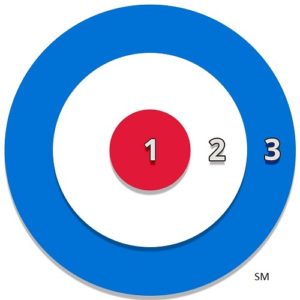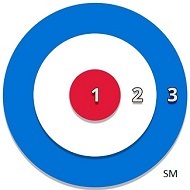This is the first chapter of Bullseye Marketing, by Louis Gudema. You can buy the book on Amazon
In this book I’ll introduce you to Bullseye Marketing which prioritizes the fastest, least expensive tactics for generating new leads and sales. And I’ll also be sharing hundreds of actionable insights and tips that you can start using right away.
With the Bullseye you work from the middle out because in the middle are the fastest and least expensive ways to produce new leads, opportunities and sales.
In Phase 1 we take full advantage of the marketing assets that the company already has — such as customers, website traffic, email lists, and our ability to listen — to quickly produce measurable results.In
Phase 2 we generate leads and sales from people who don’t yet know about us but who are looking to buy right now.
And in Phase 3 we build awareness of our company and offerings with people who are interested in our industry and solutions, could someday be customers, but (as far as we know) are not be buying right now. We want to make sure that these people know about us, and think highly of us, so that they will put us high on their short list when they are ready to buy.

Many marketers, and non-marketing executives, are so focused on spreading the word about their great offerings that without realizing it they do this in reverse order. They start with programs in the outer circle like social media, content marketing (blogging, videos, speeches, etc.) and display advertising — which usually are among the slowest and most-expensive ways to generate new business — and they miss the great opportunities that are right under their noses. And because they do this backward they all too often have poor initial results and soon give up, saying, “We knew it: marketing doesn’t work for us.”
But it could work if they used Bullseye Marketing.
So let’s look more deeply at each phase.
Phase 1 — Fully Exploit Your Existing Marketing Assets
Whether you’re starting marketing from zero or proposing a major strategic expansion to existing marketing programs, you’ll usually need to start out with a small budget and produce some quick, inexpensive results to build confidence among the executives in your company. You may only have six months, if that, to produce some quick wins.
That’s where the Phase 1 activities described in chapters 2 through 9 come in. You’re going to start with the marketing assets that your company already has and exploit them to quickly produce impressive results.
It’s kind of like taking leftovers and — surprise! — turning them into a delicious casserole.
Some of the under-utilized marketing assets that you can quickly work magic with are…
· Customers
o Gain a better understanding of them so that all of your marketing activities can be as effective as possible. (Which I cover in chapter 3.)
o Market and sell more to your existing customers. It’s estimated that it’s five to 25 times more expensive to close a new account than to retain and grow an existing one. Yet in many companies a much greater emphasis is put on closing new accounts.[ix] (Chapter 4)
· Website: Your website probably already has a fair amount of traffic, but on most websites 99% — or more — of visitors come and go without anyone knowing who they are or what they are interested in. With the Bullseye approach you’re going to sharpen your message and improve the experience of visitors. (Chapter 5)
· Conversion Rate Optimization: This is the process for getting more people who come to your website, for example, to do what you want them to do. You may want people to make a purchase, sign up for a webinar, download an infographic, contact your salespeople, or something else — these are all called “conversions”. At a minimum you want their email address and their permission to continue to update (market to) them. Improving your conversion rate is perhaps the fastest, least expensive way to increase your leads and reduce your cost per lead. (Chapter 6)
· Email lists: Consulting firm McKinsey & Company estimates that email marketing is 40 times more effective for customer acquisition than Facebook and Twitter.[x] And marketers routinely describe as the digital channel with the highest ROI.[xi] Bullseye marketers don’t buy lists or spam people; we grow and use a house list to provide useful information that contacts, prospects, and customers value. (Chapter 7)
· Remarketing: Remarketing ads are those ads that follow you around the Internet after you’ve looked at a website. Love them or hate them, remarketing is inexpensive and effective — a combination that we Bullseye marketers always like, especially in Phase 1. (Chapter 8)
· The sales team: you’re going to work more closely with sales than ever before to better understand your customers, grow your current accounts, and close new accounts. (Chapter 9)
Most companies have low hanging marketing fruit all over the place. We’re going to show you how to harvest it.
You can implement some of these Phase 1 activities very quickly and inexpensively; at some companies that I’ve worked with we doubled or tripled web leads in just a few weeks. That should get the attention of the CEO and others in your company and start to build your credibility.
With your Phase 1 success, you’ll be ready to move on to Phase 2.
Phase 2 — Sell to People Who Want to Buy Now
Phase 2 is when you focus on getting the attention of new people who intend to buy what you’re selling very soon — a perfect audience.
To do this, we focus on “intent data” — information that helps us identify these active shoppers, whether consumers or B2B companies. Here are three ways to identify and take advantage of intent…
· Search advertising: People who are searching on certain phrases are very likely researching a purchase. But clicks on search results on Google and Bing are focused primarily on the first 3 or 4 spots on the search results page. In many industries the competition for those spots is so great that it may be difficult or impossible to win them. However, you can still connect with people searching for your offerings by running paid search ads. You can get an initial campaign up and running in minutes. (Chapter 11)
· Track the most frequent visitors to your website, and the people who engage with all of your content (emails, events, webinars, social media, etc.). If a person, or several people from the same company, repeatedly visit your site and engage with your content, that’s a good sign that they may be in buying mode.
· Use third-party intent data. Large retailers like Kroger sell their store and website data to non-competitors. And some intent data vendors gather information from many websites about the search and reading activities of people from B2B companies; they identify in-market companies by a surge in their searches and reading and sell that information to B2B companies. (Chapter 12)
By using these expressions of intent in search ads, interaction with your content, and third-party data, you can run an efficient program by identifying the customers who are most likely to buy now.
Phase 3 — Cast a Wider Net with Long-Term Awareness and Branding Programs
With the success of Phases 1 and 2 you should have enough credibility in your company to undertake some longer range marketing programs. Phase 3 consists of activities that may not produce an immediate return but, when well done, will have an impact over 6, 12, 24 months and beyond.
Some of the programs that you may do in Phase 3 include:
· Content marketing (Chapter 13)
· Search engine optimization (Chapter 14)
· Video, TV and podcasts (Chapter 15)
· Social media (Chapter 16)
· PR and influencer marketing (Chapter 17)
· Events and trade shows (Chapter 18)
· Online and offline display ads (Chapters 19 and 21)
· Direct mail (Chapter 20)
And more.
In companies where Phase 3 activities are being done well, when sales reps ask a new lead how they heard about the company they’ll often get a response like, “I saw you everywhere. I figured I had to talk with you.”
The fastest and least expensive leads and sales are, initially anyway, in the center of the Bullseye. As you move out from the center toward the edge the cost for each new lead and sale is likely to increase and your ROI decrease, at least in the short term. Why do it then? Because you can’t generate enough new business by only doing the Phase 1 and 2 activities and your company wants more. And even if it’s more expensive in the outer ring to acquire new customers, it’s still low enough to justify the marketing.
Every company is different, and which channels will work best for you will vary for reasons that we’ll discuss later. Every campaign is an experiment.
Now, the Bullseye looks like it has hard edges between each phase. In fact, there is some overlap — leakage even — between phases. For example, improvements that you make to your landing pages as part of conversion rate optimization in Phase I will help the performance of your paid search ads in Phase 2. You could host events for current customers in Phase1, but expand them to a far broader audience in Phase 3.
And, no, you don’t necessarily have to do these in this exact sequence. You could ramp up all three phases simultaneously if you have the people, executive buy-in, and resources. But usually you’ll be far more successful if you create a solid foundation with the Phase 1 activities before moving on to the other programs.
With the Bullseye approach you’re not just throwing out a bunch of random campaigns and hoping that they will have an effect: you’re carefully building out an omni-channel marketing program that gets the right message to the right person at the right time.
Now let’s drill down into the three Bullseye phases in more detail.
Now please go to the book website to sign up for updates on its launch and when you can pre-order it.
—————–
(c) Copyright 2018, Louis Gudema. All rights reserved.
[/fusion_text][/fusion_builder_column][/fusion_builder_row][/fusion_builder_container]
